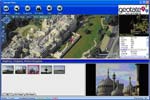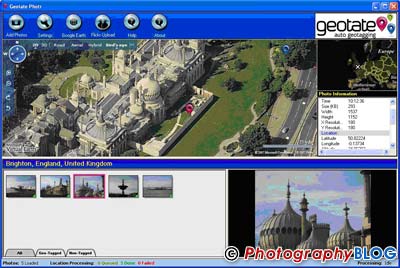Geotate GPS for Digital Cameras
 Geotate has announced the commercial availability of a radical geotagging solution for the digital camera market. Geotate’s new GPS solution, “Capture and Process”, captures raw GPS satellite signals in available memory, a low-cost and low-power method of handling GPS signals. Hans Streng, CEO of Geotate, said: “We expect in the region of four million cameras in the next 18 months to two years to come with embedded geotagging functionality.” Geotate’s “Capture and Process” GPS technology will become commercially available in two modules in the first quarter of 2008.
Geotate has announced the commercial availability of a radical geotagging solution for the digital camera market. Geotate’s new GPS solution, “Capture and Process”, captures raw GPS satellite signals in available memory, a low-cost and low-power method of handling GPS signals. Hans Streng, CEO of Geotate, said: “We expect in the region of four million cameras in the next 18 months to two years to come with embedded geotagging functionality.” Geotate’s “Capture and Process” GPS technology will become commercially available in two modules in the first quarter of 2008.
Geotate Press Release
Instant GPS camera technology set to explode location tagging of pictures
Geotate announces commercial availability of radical “geotagging” solution for digital camera market
LAS VEGAS, USA, 30 January 2008: Geotate, a software GPS-company which delivers location-based solutions via a radically different method, announced the commercial availability of its instant GPS solution, “Capture and Process”, in the first quarter of 2008. Geotate uses software-based GPS technology to ‘geotag’, or mark with location data, digital files on portable devices such as digital cameras. The new technology will, for the first time, allow mainstream digital camera makers to enter into the market for GPS in consumer devices, a sector IMS Research predicts will increase five-fold by 2011[1].
“New advances in GPS and location based services, such as geotagging are driving growth of GPS into consumer devices such as cameras and laptops. We expect to see the market take off in 2008 with well over one million GPS-enabled cameras sold and strong growth forecast for the next four years, thanks to new, disruptive technologies like geotagging coming of age,” said Matia Grossi, analyst at IMS Research.
Geotate’s approach captures raw GPS satellite signals in the available memory using its patented technology to later be unlocked via web-based services. This unique low-cost and low-power method of handling GPS satellite signals removes essential hurdles for the use of GPS signals in resource-limited devices such as digital cameras, location-loggers and other devices.
Hans Streng, CEO of Geotate, said: “We expect in the region of four million cameras in the next 18 months to two years to come with embedded geotagging functionality. Until now, embedding GPS in portable devices has incurred lag times of 30 seconds to a minute, resulting in a clunky customer experience. Nobody is going to say ‘Hey, hold that pose for a minute while I fire up the GPS’. For the first time, a spontaneous, instantaneous GPS solution is available that meets the consumer’s high expectations and provides market differentiation for camera manufacturers.” Furthermore, growing demand for GPS functionality in portable devices such as digital cameras is being spurred on by the phenomenon of social networking. Popular sites such as Flickr, YouTube and Facebook already enable users to manually tag content. The creation of a “geoweb” is now being advanced by a series of new technologies, concepts and products like Geotate’s “Capture and Process” which enables users to intuitively and instantly add a new, physical dimension to existing online communities.
Matia Grossi, IMS Research, explained, “Photo sites and online communities need to maintain financial growth through traffic-based business; camera manufacturers need to differentiate in an increasingly competitive market; and end users need new and innovative management functionalities for their photo libraries. GPS is potentially the answer.”
Geotate’s “Capture and Process” technology will become commercially available in two modules in the first quarter of 2008, aimed at differing user needs:
· YuMa – automatic geotagging solution aimed at camera manufacturers for their DSC product lines. Geotate’s “Capture and Process” approach ensures an instant geo fix whilst solving the problem of lag time.
· HoPi – automatic geotagging solution for photo accessory and peripherals manufacturers. “Capture and Process” technology solves the problems of battery consumption and instant capture for photo matching accessories, enabling camera and internet users to share experiences quickly and easily.
About Geotate
Geotate is a wholly-owned subsidiary of NXP which is in the final stage of spinout negotiations with an investor. Final agreement is expected in the near future and closing by the end of the first quarter of 2008, after which NXP will hold a minority position. Further details of the agreement, including the name of the investor and financial terms, are not disclosed. Geotate is a geo software company whose solutions enable portable devices to automatically add a geotag to an object without compromising the user experience and the devices’ resources. Geotate’s patented approach captures raw GPS satellite signals in the available memory that are later unlocked via a web-based service. This disruptive technology enables instant, intuitive “auto geotagging”.
Geotate Press Release
Geotate and Rakon Create Geotagging Module for Camera Industry
Co-development combines innovative ‘Capture and Process’ software with GPS RF technology
LAS VEGAS, USA, 30 January 2008: Geotate, a software GPS-company which delivers location based solutions for consumer devices, announced that it has successfully collaborated with Rakon Limited (Auckland, New Zealand, NZX:RAK), to develop a solution using Rakon’s GRM 6510 module. This module, that includes all the required GPS RF hardware (excluding antenna) to capture raw GPS data, can be combined with Geotate’s GPS software to provide a geotagging solution that can easily be added to consumer electronics devices such as digital cameras.
The low power module has a small footprint of 1/4 inch x 1/5 inch (6mm x 5mm), that is entirely self-contained and incorporates all critical elements such as LNA, RF ASIC, SAW filter, IF filter and 0.5ppm TCXO on a ceramic substrate. The module is fully tested and will reduce the end product’s test time whilst virtually eliminating design time and uncertainty involved in a conventional discrete design.
“We believe that the speed of accessing the GPS data and the cost of the overall solution makes this geotagging solution to be the only viable way GPS technology will be incorporated into the vast majority of digital cameras. By working with a leading GPS specialist, we have created a solution that minimizes integration time and cost for camera makers and is ready to implement immediately,” commented Hans Streng, Chief Executive Officer of Geotate.
“Geotate’s innovative software is a real breakthrough in the development of GPS for the camera industry. We are confident that, combined with our module, it will enable geotagging solutions to be incorporated into many cameras this year,” commented Rakon Managing Director, Brent Robinson.
Rakon pioneered the development of miniature oscillators capable of maintaining high levels of accuracy and unique lock-on stability in extreme environments. As a result, Rakon supplies over 50% of the frequency control devices used by the GPS industry.
About Geotate
Geotate is a wholly-owned subsidiary of NXP which is in the final stage of spinout negotiations with an investor. Final agreement is expected in the near future and closing by the end of the first quarter of 2008, after which NXP will hold a minority position. Further details of the agreement, including the name of the investor and financial terms, are not disclosed. Geotate is a geo software company whose solutions enable portable devices to automatically add a geotag to an object without compromising the user experience and the devices’ resources. Geotate’s patented approach captures raw GPS satellite signals in the available memory that are later unlocked via a web-based service. This disruptive technology enables instant, intuitive “auto geotagging”.
About Rakon
Rakon Limited- “Rakon” (NZX:RAK) is a world leader in the development of frequency control solutions for a wide range of applications. Rakon has leading market positions in the supply of crystal oscillators to the GPS, telecommunications network timing/synchronization and aerospace markets.
Rakon has a diverse product portfolio from low stability XO and crystal products, through to high volume TCXO and VCXOs and precision OCXO and Rubidium equivalent frequency standards.
Rakon is based in Auckland, New Zealand with principle manufacturing operations in New Zealand, the United Kingdom and France and sales offices throughout the world. For more information visit its website at www.rakon.com.
[1] IMS Research: The Worldwide Market for GPS/GNSS-enabled Portable Devices – November 2007


Loading comments…